
Squats vs Lunges: Is One Better than the Other?
Key Takeaways
- Squats and lunges are different functional exercises that work the lower body muscles.
- Squats are great for beginners to learn first, while lunges take more coordination and balance to learn. Both should be started with bodyweight only until perfect form is established.
- Squats will help build overall muscle mass while also improving performance and strength.
- Lunges are great to define and shape the legs and glutes, while also improving balance, coordination, and stability.
- Choosing which one to do will ultimately depend on your activity level, fitness goals, and skill level.
Depending on your workout goals, you may be focusing more on your upper body than your lower body. If this is the case, you’ll definitely want to make sure you start carving out time for lower-body workouts.
Having a strong lower body has its benefits: better posture, improved stamina, and stronger lifts.
These are just a few of the benefits. Plus, you don’t want to be that person in the gym with an impressive upper body and tiny legs.
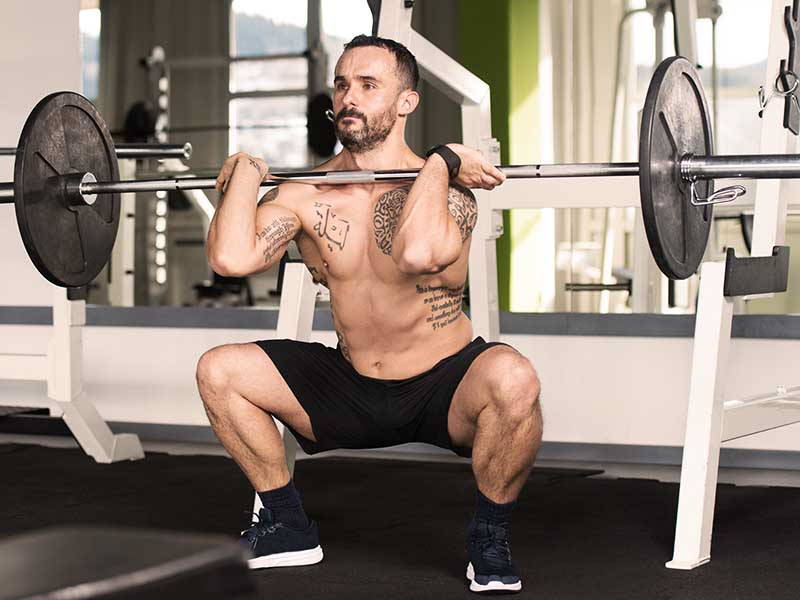
Proportions count, not just aesthetically. If you suffer from a more developed upper body than lower body, you should consider some changes.
When creating your lower-body workout routine, do you wonder if you should focus more on lunges or squats?
When it comes to squats vs lunges, one may be better than the other to help you achieve your goals.
Today, we’ll look at squats and lunges, their benefits, and the different variations of each exercise. Then, we’ll consider different reasons you may want to consider doing squats vs lunges to meet your goals.
Squats 101: What are Squats?
First, let’s take a look at what a squat exercise actually is.
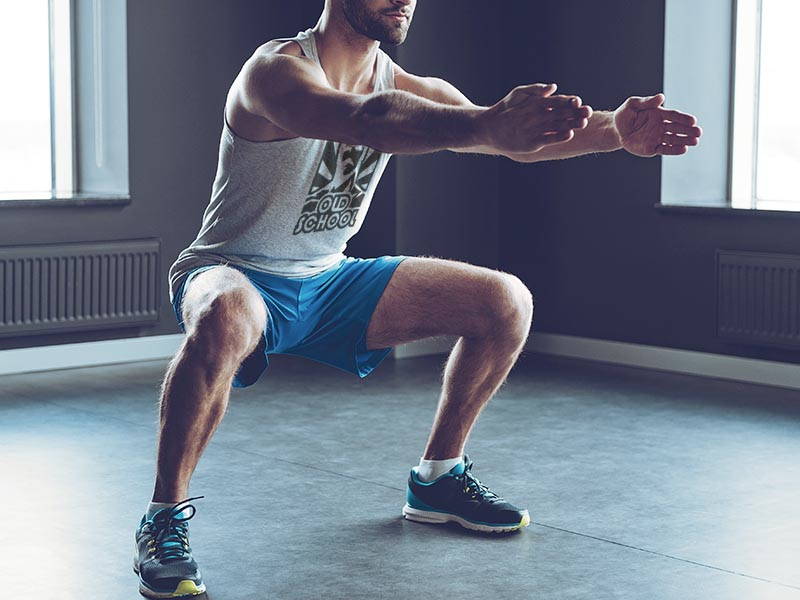
A squat is considered a compound strength exercise that consists of moving the hips down from standing to sitting position.
The user hinges at the hips, keeping the chest up and eyes forward, knees behind the toes. Once down in the seated position, the user pushes from the heels to rise back up to the starting position.
The muscles used during a squat exercise include:
- Quads
- Glutes
- Thighs
- Soleus (calf muscle)
- Erector spinae
- Abs
- Obliques
- Hamstrings
The squat works the entire posterior chain and can be considered a full-body exercise, especially when weights are used. You may have heard before that squats are considered to be the king of all lower-body exercises.
Keep in mind, even if you don’t use squats as part of your workout routine, that doesn’t mean you haven’t before. After all, most of us used to do squats without realizing it when we were babies and toddlers.

If you don’t believe us, check out how a baby plays and moves around their daily lives. Sooner or later, you’ll notice that they are unknowingly squatting to play.
Not sure about proper form when completing a squat exercise? Check out this step-by-step guide to learn how to do it properly to avoid injury.
There are many benefits to keeping squats as part of your workout routine throughout life. Here are some of those benefits.
Benefits of Squats
There are numerous benefits to doing squats as part of your workout routine. Let’s take a look at some to consider.
- Increase core strength
- Improves posture
- Improves circulation
- Builds overall muscle mass and strength
- Targets the glutes (especially deep squats)
- Doesn’t put unwanted pressure on the knee joints
- Helps improve balance and coordination
- Can help regulate bowel movements
- Improve everyday tasks (as a functional exercise)
- Increase testosterone production
- Can be done with no equipment (certain variations do require equipment)
- Improve jump height

Squats also help maintain functional performance as we age, which is important to the activities of daily living (ADL).
Transferring (getting up and down from a seated position) is one of the keys to maintaining an independent lifestyle.
Different Variations of Squats
There are also different variations of the squat exercise that can target different muscles and benefits. Let’s see what variations you can do when squatting.
Bodyweight Squats
- Basic squat
- Jump squat
- Pop squat
- Pistol squat
- Split squat
- Flamingo squat
- Hindu squat
Squats with Weights
- Back squat
- Hack squat
- Front squat
- Overhead squat
- Loaded squat jump
- Zercher squat
- Belt squat
- Goblet squat
- Bulgarian squat
- Trap bar squat
Squats with Machines/Equipment
- Box squat
- Bench squat
- Band squat
- Sissy squat
- TRX squats (with additional variations)
- Bosu ball squat
- Smith machine squat
- Box jump to squat
As you can see, there are many different variations that can be done with or without equipment. Now, let’s take a look at what lunges are, their benefits, and variations.
What are Lunges?
Essentially, a lunge is where the front leg is bent at the knee with the foot flat on the floor, and the back leg is bent behind. Lunges are used by athletes, weight lifters, and even as part of yoga practices.
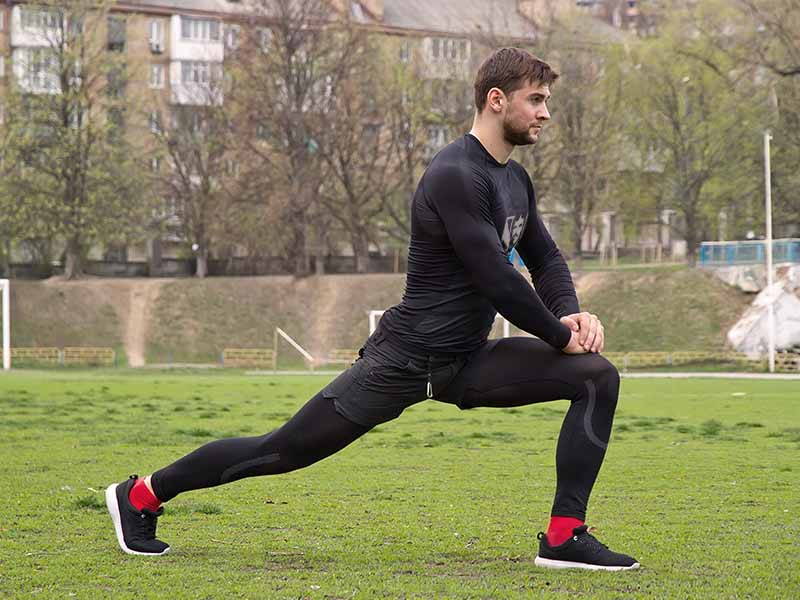
Some confuse a split squat with a lunge, and while they are very similar, there is a key difference.
In a lunge, both the front and back legs are activated during the exercise. In a split squat, the rear leg is at rest and all weight is put on the front leg.
You also remain stationary during a split squat and move either forward or backward completing a lunge.
The muscles used during the lunge exercise include:
- Glutes
- Quads
- Hamstrings
To complete a lunge with proper form, be sure to check out this step-by-step guide before you start.
Benefits of Lunges
There are benefits to completing lunges as part of your lower body workout routine. Here are a few benefits to consider:
- Improves core stability
- Improves stability and balance
- Increase body symmetry
- Improves function and flexibility
- Improves coordination
- Tightens the glutes
- Improve running speed in athletes
- Improves lower body strength
Lunges are also frequently used in rehabilitation programs and can prevent hamstring injuries.
Different Variations of Lunges
There aren’t quite as many variations of the lunge as there is to the squat, but there are still quite a few. Lunges can also be combined to create a compound exercise that focuses on other muscle groups.
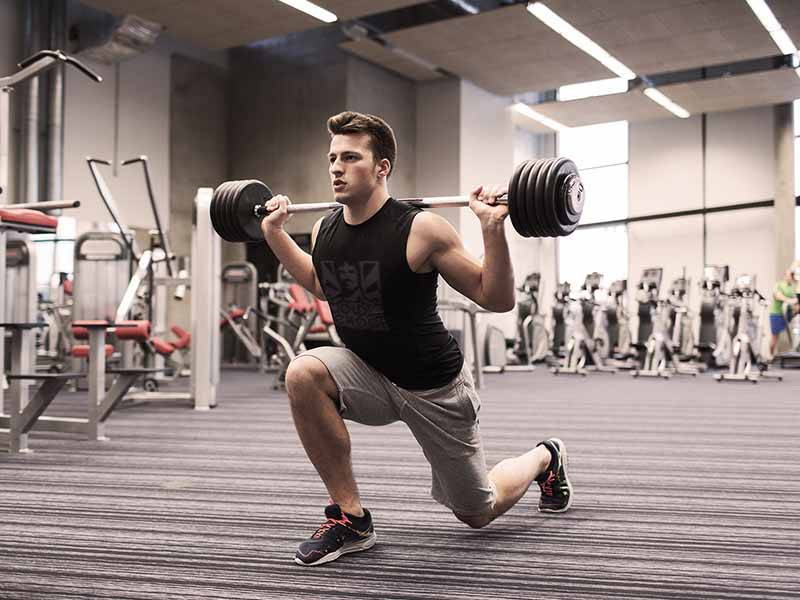
Here are some different variations of the lunge:
Bodyweight Lunges
- Walking lunge
- Forward lunge
- Reverse lunge
- Clock lunge
- Lateral lunge
- Curtsy lunge
- Elevated reverse lunge
- Reverse lunge with kick
- Split jump lunge
- Mountain climber lunge
Lunges with Weights
- Woodchop lunge
- Lunge with bicep curl
- Walking lunge with medicine ball twist
- Dumbbell reverse lunge
- Walking dumbbell lunge
- Dumbbell lateral lunge
- Overhead lunge
- Lateral raise lunge
Pretty much any lunge can be done with or without weights. Different variations target muscle groups differently, so you can easily make an entire leg day out of lunges.
Before you add any weight to your workout, be sure to perfect for form doing a basic bodyweight lunge first.
Now that we’ve discussed what the squat and lunge are, let’s see if one might be better than the other.
Squats vs Lunges for Beginners
If you are a beginner or know someone who is just getting started working out, one exercise is better. Squats don’t require as much balance and coordination as lunges, so they are better for beginners.
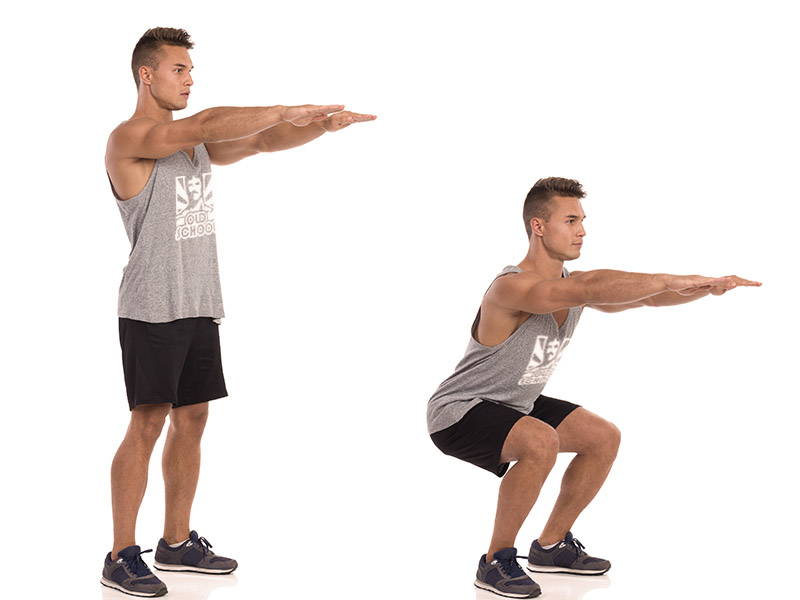
Start out first with just bodyweight to perfect form, then slowly start to add weights. Begin with a chair or bench underneath to really get the form down and also reduce the risk of injury.
When just starting out, limit your squats to one or two sets of up to 12 reps. Complete squats up to twice a week, then add on reps, sets, and time spent as your form improves.
You can also add variations and weights to further challenge yourself.
Once you feel that your lower body has improved strength and balance, work on lunges.
Squats vs Lunges for Runners
When it comes to runners, are squats or lunges a better exercise to focus on? Honestly, it depends on your goals.
Some runners don’t do enough strength training exercises, which can hurt their running times. This is especially true for distance runners.

Squats can help not only build strength and muscle mass, but also improve endurance.
If you notice that you might have an imbalance from one leg to the next, lunges can target the imbalance. This will create symmetry in your gait, which can also help decrease the risk of injury when running.
As a runner, doing a combination of squats and lunges can help improve your running times, function, and stamina.
Lunges vs Squats for Athletes
Is there a benefit to choosing either squats or lunges when increasing athletic performance? There doesn’t seem to be a large enough perceived benefit to choosing one over the other.
However, lunges can work on muscular imbalance from one side to the other. If your goal is to create symmetry, focus more on lunges until the imbalance is corrected.
Step-ups may also be considered to improve imbalances.
Walking lunges will also help with endurance, posterior firing, and knee strength. Using the different exercise variations combined with varying intensities are key to athletic improvement.
Squats can also be used to create a solid foundation for athletes, especially when started young. By perfecting form using an unloaded squat, young athletes can improve performance and reduce injury.
This can lead them to a long and active life with less potential career-ending injuries.

Both lunges and squats can help athletes in any sport build a solid foundation for their lower body. Following a structured regimen of both exercises can help with:
- Running
- Transitioning (like in football or basketball)
- Jumping
- Sprinting
- Pitching
- Lifting
As the athlete works through the exercises, learning form through measured progressions, they’ll get in tune with their body mechanics. Every sport can benefit from squat and lunge variations.
The versatility of both squats and lunges can be used to the athlete’s advantage. Define your goals and then create a lower-body workout routine that aligns with those goals.
This will provide the best results, tailored specifically to your individual needs.
Lunges vs Squats for Bodybuilding
Comparing squats vs lunges, which do you think works better for someone focused on bodybuilding? For this sport, you will definitely want to focus more on squats than lunges.
The main reason is that squats help build greater strength and muscle mass, requirements for bodybuilding. You can also lift much more weight with squats than you can when performing lunges.

Golden Era legend & Old School Labs ambassador Tom Platz built his career on his squat performance. Once he perfected the squat and started adding weight to it, his physique became one of the best of its time.
Some compare deadlifts vs squats, and while similar, there are some key differences. Before you start deadlifting, you will definitely want to get a foundation with squats first.
If you plan to compete as a powerlifter, deadlifting and squats are two of the three strength tests. If you are just starting out, focus on squats before you add on any weights and then work on your deadlifts.
Working Your Glutes? Which One is Better?
If you are looking to get a more firm or shapely buttocks, should you do squats and lunges? Yes, even some men have goals to create a better posterior, this is not just for the ladies.

If you want to get a bigger and more shapely butt, you should be doing both. We did an entire breakdown of which squat and lunge exercises are best for the glutes.
Make sure you check it out if you want to work on enhancing your glutes.
Another benefit of shaping and building strength in the glutes is that it can reduce the appearance of cellulite. As we learned before, there is no cure for cellulite, but squats and lunges can help.
Want more ways to reduce cellulite? Check out the link above to find alternative ways that might help.
Creating a Winning Workout Strategy
Now that you’ve learned about squats vs lunges and which might work better for you, it’s time to create a plan.
If you’re a beginner, then you will only be doing legs one to two days a week. More advanced athletes and bodybuilders may be doing them as much as three to four times a week.
When creating your leg day workout routine, here a few things to consider. To stimulate muscle growth and recovery, stick with lower reps and higher sets.

According to this study, the optimal number of sets for hormonal responses to stimulate recovery and growth is six sets.
This means that you’ll want to do no more than eight reps per set, and probably even less. Also, consider the amount of rest time needed between each set.
To increase muscle endurance and strength, you’ll want to rest between 20 seconds and one minute.
Now that we’ve got the time and reps vs sets down, let’s put together a sample leg day routine.
Leg Day Routine – Beginner
This routine will work best for a beginner. We’re going to go light on the weights for now, because the form is most important.

- Warm-up – standing forward bend – hold for 8 – 10 deep breaths
- Warm-up – kneeling hip flexor stretch – hold for 30 seconds on each leg
- Bodyweight squats – 6 reps for a total of 4 sets, 20-second rest between each set
- Dumbbell step-ups – 5 reps for a total of 4 sets, 30-second rest between sets
- Split squat – 4 reps for a total of 4 sets, 30-second rest between sets
- Forward lunge – 5 reps for a total of 4 sets, 20-second rest between sets
Leg Day Routine – Advanced
Advanced lifters can step up their leg day routine with more reps and sets and heavier weights.

Here’s a sample to work from:
- Same warm-ups as beginner
- Back squat – 5 reps for a total of 6 sets, take up to 45 seconds between sets
- Reverse weighted lunge – 6 reps for a total of 5 sets, take up to 45 seconds between sets
- Overhead squat – 5 reps for a total of 6 sets, take up to 60 seconds between sets
- Single leg deadlift – 5 reps for a total of 6 sets (3 each leg), take up to 60 seconds between sets
- Bulgarian split squat – 6 reps for a total of 4 sets (2 each leg), take up to 45 seconds between sets to rest
- Calf Raises – complete 6 reps for 5 sets, take up to 45 seconds between sets
- Farmers carry – 6 reps for a total of 5 sets, take up to 45 seconds between sets
- Hack squats – 6 reps for a total of 6 sets, take up to 60 seconds between each set
Feel free to combine leg day with another muscle group if you want to spend more time in the gym. Your fitness goals will dictate how many days each week you should work out, and for how long.
Final Thoughts
When it comes to the battle of squats vs lunges, the answer to which is better comes down to your goals. It seems like many of these battles have the same conclusion, but that’s because it’s true.
If you are looking to build overall strength and muscle mass, then you’ll want to focus more on squats. There are different variations of the exercise, and they can be done with bodyweight or a barbell.
However, if you have any type of back injury, you should get clearance from a doctor first.

Working on improving balance, shaping hamstrings and glutes, or increasing leg strength? Then you’ll want to focus more on lunges and incorporate different variations to shape your muscles.
As always, ensure you have perfect form before adding any weight to either exercise. Get a knowledgeable spotter or trainer to assist you in the mechanics.
Then, you can add either or both of these leg exercises to your weekly rotation.
Do you prefer squats or lunges, or do you incorporate both into your routine? What is your preferred squat and/or lunge exercise? We’d love to hear about it in the comments section below.











